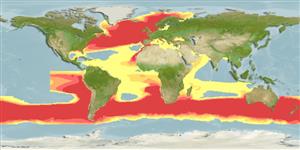Common names from other countries
分类 / Names
俗名 | 同种异名 | Catalog of Fishes(属, 种) | ITIS | CoL | WoRMS | Cloffa
Elasmobranchii
板鳃亚纲 (鲨鱼与 鱼) (sharks and rays) >
Lamniformes (Mackerel sharks) >
Lamnidae (Mackerel sharks or white shark)
Etymology: Lamna: From the Greek lamia, a large and voracious shark, originally from Lamia in Greek mythology, daughter of King Belos, who revenged the murder of her children by killing the children of others, and who behaved so cruelly that her face turned into a nightmarish mask. (See ETYFish); nasus: Latin for nose, referring to moderately long conical snout. (See ETYFish).
More on author: Bonnaterre.
Environment: milieu / climate zone / depth range / distribution range
生态学
海洋; 海洋洄游的 (Ref. 51243); 深度上下限 0 - 1360 m (Ref. 114967), usually 0 - 300 m (Ref. 119696). 溫帶; -1°C - 23°C (Ref. 98315); 76°N - 59°S, 180°W - 180°E (Ref. 247)
Circumglobal, amphitemperature with centers of distribution in the North Atlantic and temperate water of the southern hemisphere; not in equatorial seas.
南北溫帶。 西大西洋: 加拿大紐芬蘭到紐澤西州美國; 可能地巴西南部到阿根廷。 東大西洋: 冰島與 Barents海西部到南非, 包括地中海。 西南太平洋: 澳洲與紐西蘭。 東南太平洋: 智利。 南極海: 外海的南喬治亞州與凱爾蓋朗群島。 印度洋.(參考文獻 6871)
Length at first maturity / 大小 / 重量 / 年龄
Maturity: Lm 186.5, range 170 - 219 cm
Max length : 350 cm TL 雄鱼/尚未辨别雌雄; (Ref. 4645); common length : 244 cm TL 雄鱼/尚未辨别雌雄; (Ref. 5951); 最大体重: 230.0 kg (Ref. 40637); 最大年龄: 65 年 (Ref. 119696)
背棘 (总数) : 0; 臀棘: 0. A stout, spindle-shaped shark with large black eyes, a sharp, conical snout, long gill slits, and small, smooth-edged, narrow teeth with side cusps (Ref. 5578, 88171). Strong keels on the caudal peduncle, short secondary keels on the caudal base, and a crescentic caudal fin; the insertion of the small second dorsal fin is above the insertion of the anal fin (Ref. 88171). Dark grey dorsally, white ventrally, without blotches (Ref. 6581, 43278); rear tip of 1st dorsal abruptly white (Ref. 5578).
矮胖, 纺锤形的鲨鱼有大的黑色眼,一个锐利又锥形吻, 与小的,边缘平滑的,和狭窄的牙齿有旁的尖头.(参考文献 5578) 背面暗灰色的,腹面白色的, 没有斑块;(参考文献 6581) 第一背鳍的后顶端醒目的白色.(参考文献 5578)
Occurs inshore to offshore fishing banks and occasionally to open ocean areas. It is migratory, moves generally along the continental shelves (inshore to surface during simmer) and winters offshore in deeper water (Ref. 58085). Most abundant on continental offshore fishing banks but also found far from land in ocean basins and occasionally close inshore (Ref. 247). Extreme depth reported to 1,360 meters. Age attained in North Atlantic at least 26 years and in the Southern Hemisphere probably 65 years (Ref. 119696). Specimens tagged off southern England were recaptured in northern Norway (having travelled 2,370 km), Denmark and Spain (Ref. 88752, 88753). The northwest Atlantic stock migrates from Newfoundland, Canada in the winter to Massachusetts in the summer (Ref. 43278, 88754). Trans-Atlantic migrations have also been recorded. One of the most cold-tolerant sharks; in the northwest Atlantic mostly found from 5-10°C (Ref. 88755); with extremes of -1°C and 23°C (Ref. 119696). Known to temporarily tolerate salinities as low as 10 to follow its prey (Ref. 88740). Found singly and in schools and feeding aggregations (Ref. 247). Feeds on small and medium-sized pelagic schooling species, other sharks, squid (Ref. 5578) and demersal fishes (cod, white hake, red hake, haddock and cusk (Ref. 5951, 43278)). Ovoviviparous species (Ref. 43278, 50449). Females grow larger than males (Ref. 88756). Parasites include Phyllobothrium dagnallium (found in stomach, intestine and spiral valve) and Dinobothrium sp. (Ref. 5951). Regarded as potentially dangerous to people because of its size and activity but has never or very seldom been indicted in an attack on people or boats (Ref. 247). Considered by some as a sport fish (Ref. 84357). The flesh of the porbeagle is of good quality and texture and is said to taste like swordfish (Ref. 84357). Utilized fresh, dried or salted and frozen for human consumption; for oil and fishmeal; fins for shark-fin soup (Ref. 247). May be pan-fried and broiled (Ref. 9988). Catch records and studies in the northeast Atlantic show segregation by sex and size (Ref. 56108, 88756, 88757).
最丰富的在大陆的外海钓鱼浅堆上也发现在海洋流域远离土地与偶然地近岸.(参考文献 247) 各别地发现与成群与觅食群集.(参考文献 247) 吃小型大洋性鱼类群游性鱼,其他的鲨鱼与乌贼。 (参考文献 5578) 卵胎生的, 胚胎吃产生于母亲的卵黄囊与其他的卵.(参考文献 50449) 1 到 5个幼胎一胎。 (参考文献 247) 被认为对人类可能有危险性了由于它的大小与活动但是从不或极少在对人或船的攻击被起诉.(参考文献 247) 生鲜使用, 干燥或盐腌与冷冻供人类消费; 用做鱼油与鱼粉; 鳍用於魚翅湯.(參考文獻 247) 可能是油鍋炸而火烤的.(參考文獻 9988)
Distinct pairing with embrace (Ref. 205). Ovoviviparous (aplacental viviparity), with uterine cannibalism (embryos feeding on other ova produced by the mother (oophagy) after the yolk sac is absorbed) (Ref. 43278, 50449). With 1-5 (usually 4) pups in a litter (Ref. 6871, 43278). Reproduction probably yearly (Ref. 45602). In the northeast Atlantic, breeding grounds are off the coast of Europe and the British Isles. Embryos found in mature females throughout the year except from July to September. Mating occurs in late summer, pups are born in the spring of the following year (Ref. 43278). Gestation may last 8-9 months. Size at birth 60-80 cm TL (Ref. 6871, 43278).南北溫帶。 西大西洋: 加拿大紐芬蘭到紐澤西州美國; 可能地巴西南部到阿根廷。 東大西洋: 冰島與 Barents海西部到南非, 包括地中海。 西南太平洋: 澳洲與紐西蘭。 東南太平洋: 智利。 南極海: 外海的南喬治亞州與凱爾蓋朗群島。 印度洋.(參考文獻 6871)
Compagno, L.J.V., 1984. FAO Species Catalogue. Vol. 4. Sharks of the world. An annotated and illustrated catalogue of shark species known to date. Part 1 - Hexanchiformes to Lamniformes. FAO Fish. Synop. 125(4/1):1-249. Rome, FAO. (Ref. 247)
人类利用
渔业: 商业性; 游钓鱼种: 是的
工具
特别资料
下载 XML
网络资源
Estimates based on models
Preferred temperature (Ref.
115969): 3.1 - 16.3, mean 7.8 (based on 1486 cells).
Phylogenetic diversity index (Ref.
82804): PD
50 = 0.7813 [Uniqueness, from 0.5 = low to 2.0 = high].
Bayesian length-weight: a=0.01047 (0.00604 - 0.01816), b=3.03 (2.87 - 3.19), in cm Total Length, based on LWR estimates for this species & (Sub)family-body (Ref.
93245).
营养阶层 (Ref.
69278): 4.6 ±0.0 se; based on diet studies.
回复力 (Ref.
120179): 非常低的, 最小族群倍增时间超过14 年 (K=0.12; tm=5; tmax=30; Fec=1-5).
Prior r = 0.05, 95% CL = 0.03 - 0.07, Based on 3 full stock assessments.
Fishing Vulnerability (Ref.
59153): High to very high vulnerability (74 of 100).
Climate Vulnerability (Ref.
125649): High vulnerability (62 of 100).
